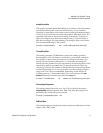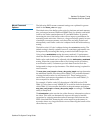StorNext File System Tuning
The Metadata Controller System
StorNext File System Tuning Guide 13
man cvfs_config page.) The snfsdefrag man page explains the command
options in greater detail.
FSM hourly statistics reporting is another very useful tool. This can show
you the mix of metadata operations being invoked by client processes, as
well as latency information for metadata operations and metadata and
journal I/O. This information is easily accessed in the cvlog log files. All
of the latency oriented stats are reported in microsecond units.
It also possible to trigger an instant FSM statistics report by setting the
Once Only debug flag using cvadmin. For example:
cvadmin -F snfs1 -e ‘debug 0x01000000’ ; tail -100 /usr/cvfs/data/snfs1/log/cvlog
The following items are a few things to watch out for:
• A non-zero value for
FSM wait SUMMARY journal waits indicates
insufficient IOPS performance of the disks assigned to the metadata
stripe group. This usually requires reducing the metadata I/O
latency time by adjusting RAID cache settings or reducing
bandwidth contention for the metadata LUN. Another possible
solution is to add another metadata stripe group to the file system.
This will improve metadata ops performance through I/O
concurrency.
• Non-zero value for
FSM wait SUMMARY free buffer waits or low hit
ratio for
FSM cache SUMMARY buffer lookups indicates the FSM
configuration setting
BufferCacheSize is insufficient.
• Non-zero value for
FSM wait SUMMARY free inode waits or low hit
ratio for
FSM cache SUMMARY inode lookups indicates the FSM
configuration setting
InodeCacheSize is insufficient.
•Large value for
FSM threads SUMMARY max busy indicates the FSM
configuration setting
ThreadPoolSize is insufficient.
• Extremely high values for
FSM cache SUMMARY inode lookups, TKN
SUMMARY TokenRequestV3
, or TKN SUMMARY TokenReqAlloc might
indicate excessive file fragmentation. If so, the
snfsdefrag utility can
be used to fix the fragmented files.
•The
VOP and TKN summary statistics indicate the count and avg/
min/max microsecond latency for the various metadata operations.
This shows what type of metadata operations are most prevalent and
most costly. These are also broken out per client, which can be useful
to identify a client that is disproportionately loading the FSM.


















